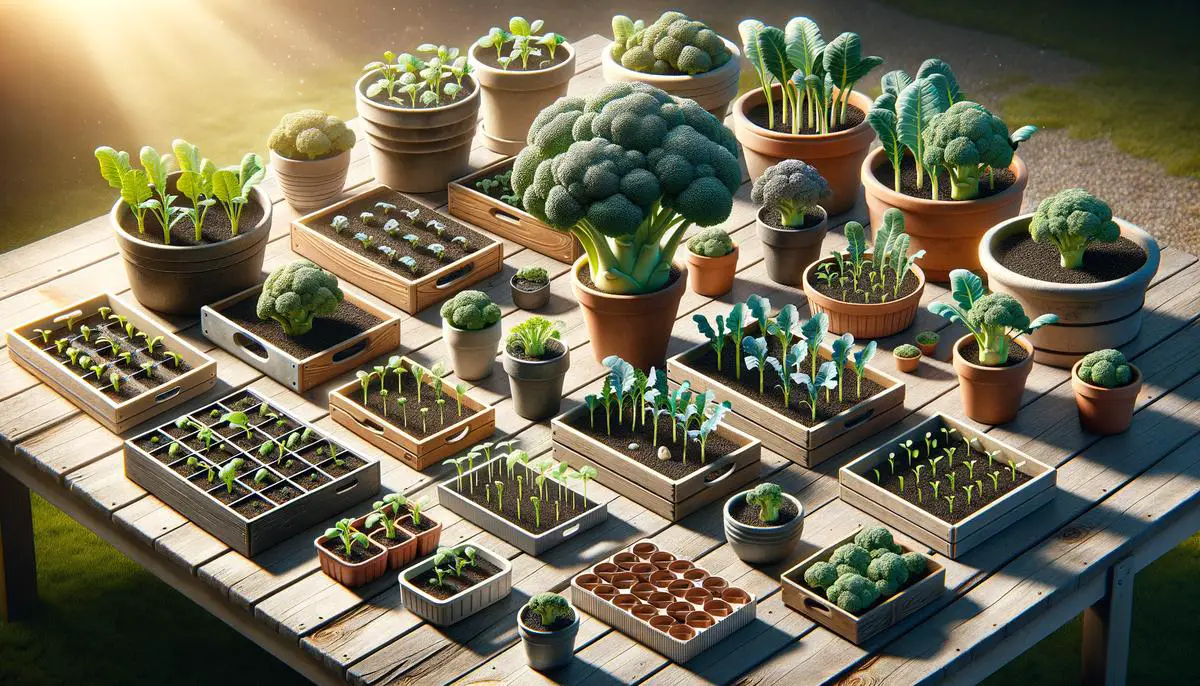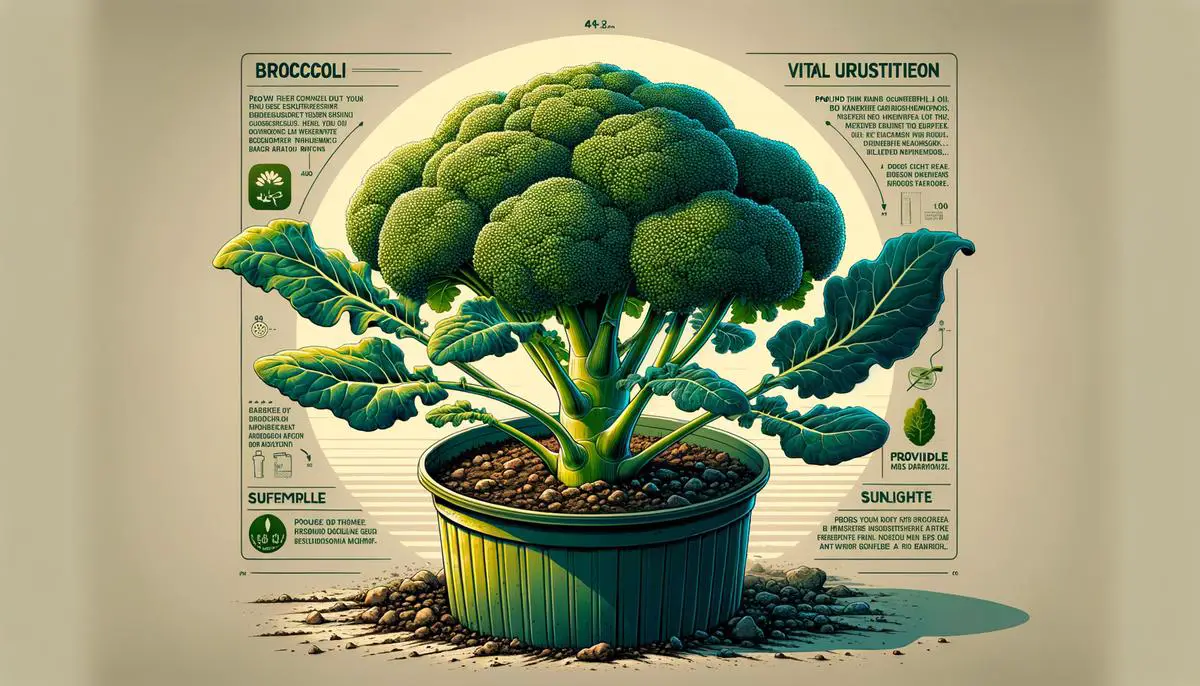Growing broccoli in containers is an exciting journey into gardening that offers a fresh, home-grown addition to your meals. Embarking on this venture requires attention to detail, starting with the selection of a suitable container. This process is not just about finding any pot, but about understanding the needs of the broccoli plant, including its deep roots and thirst for both water and sunlight. By focusing on the essentials such as the right container, soil, fertilizer, and balancing water and sunlight, you set the stage for a bountiful harvest. Let’s dive into how you can nurture a flourishing container broccoli garden right at home.
Choosing the Right Container
### Choosing the Best Container for Growing Broccoli
Reader Poll: What online courses would interest you?
Growing broccoli in a container is a fantastic way for you to enjoy this nutritious vegetable even if you have limited space. When selecting the right container for your broccoli plants, there are several key factors to consider to ensure your plants thrive. Let’s dive into the specifics of choosing the perfect container for growing broccoli.
Size Matters
First and foremost, size is crucial when it comes to selecting a container for your broccoli. Broccoli plants need room to spread out and grow, not just above the soil but below as well. Choose a container that is at least 18 inches deep and 12-18 inches in width for each broccoli plant. This size allows enough space for the roots to grow deep and strong, supporting the plant’s growth and development.
Material Makes a Difference
Containers can be made from various materials including plastic, clay, ceramic, and fabric. Each material has its benefits:
Subscribe to our newsletter!
- Plastic: Lightweight and retains moisture well, making it a good choice if you need to move your plants around. However, it can deteriorate over time if left in direct sunlight.
- Clay or Ceramic: These materials are heavier, which makes them more stable against wind. They also allow more air and moisture to pass through the walls, which can help prevent root rot. The downside is they can dry out more quickly, requiring more frequent watering.
- Fabric Pots: A more recent innovation, fabric pots promote excellent drainage and air circulation to the roots. They’re also lightweight and can be a good option if you’re looking for portability. Overwatering is less of a concern with fabric pots.
Drainage is Key
No matter the material you choose, ensure your container has adequate drainage holes at the bottom. Broccoli does not like to sit in waterlogged soil, as this can lead to root diseases. If your chosen container doesn’t have holes, you can add them yourself using a drill for hard materials or scissors for fabric pots.
Considering Color
If you’re gardening in a very sunny and hot climate, consider the color of your container. Dark-colored containers absorb more heat, which could overheat the soil and harm the roots of your broccoli plants. In hot climates, opt for light-colored containers to reflect the sun’s rays and keep the soil temperature cooler.
Final Consideration: Weight
Remember, once filled with soil and plants, containers can become quite heavy. Consider the weight of the container if you plan to move it around, especially after watering. Plastic and fabric pots are great lightweight options.
By keeping in mind these considerations—size, material, drainage, color, and weight—you’ll be well on your way to selecting the perfect container for growing broccoli. This ensures not just any harvest, but a flourishing one that lets you enjoy fresh, homegrown broccoli right from your balcony, patio, or garden space.

Soil and Fertilizer
Choosing the Right Soil Mix for Container-Grown Broccoli
Growing broccoli in containers is a rewarding venture, yet it demands the right foundation—the soil mix. For broccoli to thrive and yield abundantly, its roots require a soil mix that is rich in nutrients, well-draining yet able to retain enough moisture. Aim for a mixture of potting soil, compost, and perlite. The potting soil provides a balanced medium for growth, compost enriches the soil with essential nutrients, and perlite enhances drainage, preventing water from pooling at the roots.
A good starting point is to blend two parts potting soil, one part compost, and one part perlite. This combination ensures that your broccoli has a fertile home with adequate air circulation and moisture regulation. Always moisten the soil mix slightly before planting. This initial dampness encourages the roots to grow and explore their new environment.
Selecting the Best Fertilizer for Your Broccoli
Broccoli is known for being a heavy feeder, craving consistent access to nutrients throughout its growth cycle. An all-purpose, balanced, slow-release fertilizer is ideal for container-grown broccoli. Look for a fertilizer labeled as N-P-K 10-10-10, which stands for nitrogen, phosphorus, and potassium, respectively. These elements support the overall health, root development, and fruit production of your plants.
Apply the fertilizer according to the package instructions, typically at the time of planting and then again when the broccoli begins to form heads. Be cautious not to over-fertilize, as this can harm your plants. If you prefer organic options, fish emulsion or seaweed extract are excellent alternatives. These natural choices not only feed your broccoli but also improve the soil quality.
Watering and Monitoring
After planting your broccoli in the chosen soil mix, water it gently to settle the soil around the roots. Going forward, maintain a consistent watering schedule. The goal is to keep the soil moist but not waterlogged. Check the soil moisture by sticking your finger about an inch deep into the soil; if it feels dry, it’s time to water.
As your broccoli grows, monitor its progress and adjust care as needed. Healthy container-grown broccoli will have dark green leaves and sturdy stalks. If you notice yellowing leaves or other signs of distress, assess and adjust your watering practices, fertilizer application, or inspect for pests.
By following these steps and using the appropriate soil mix and fertilizer, you’ll create the ideal conditions for your container-grown broccoli to flourish. Remember, patience and attention to the needs of your plants will lead to a bountiful harvest of fresh, tasty broccoli right from your own balcony or patio.

Watering and Sunlight
How Much Water and Sunlight Does Container Broccoli Need?
Growing broccoli in containers is a fulfilling endeavor, but just like any garden project, it requires understanding its specific needs for water and sunlight. Let’s dive into the essentials to ensure your broccoli thrives.
Watering Your Container Broccoli:
- **Frequency:** Water your broccoli so the soil stays evenly moist, not waterlogged or dry. Typically, this means watering once every two to three days, but this can vary based on weather and soil conditions. Hotter days may require daily watering.
- **Method:** Use a watering can or hose with a gentle flow, aiming directly at the soil to avoid wetting the leaves. This approach helps prevent disease and directs water exactly where it’s needed – the roots.
- **Check the Soil:** Before watering, stick your finger about an inch into the soil. If it feels dry, it’s time to water. If it’s still moist, wait another day.
- **Morning Watering:** Try to water your broccoli in the morning. This gives the plant time to absorb water before the heat of the day and helps to prevent evaporation.
Sunlight Needs for Container Broccoli:
- **Amount of Sunlight:** Broccoli loves sunlight but appreciates a break during the hottest part of the day. Aim for about 6 to 8 hours of sunlight daily. If you live in a very hot climate, your broccoli will appreciate some afternoon shade to protect it from intense heat.
- **Positioning:** Place your container in a spot where it can get the required amount of sunlight. Remember, as the seasons change, the sun’s position also changes. Be prepared to move your container to ensure it gets enough light.
- **Observation:** Keep an eye on your plant. Signs of too much sun include wilting or yellowing leaves, while too little sun can result in spindly growth or a lack of head formation.
In summary, the success of your container-grown broccoli hinges on balancing its water and sunlight needs. Regular, measured watering to keep the soil evenly moist and providing 6 to 8 hours of sunlight daily, with protection from intense afternoon heat, will set you on the path to enjoying rich, green broccoli from your own container garden. Keep a watchful eye on these aspects, and you’ll cultivate a rewarding broccoli harvest.

Gardening, especially in containers, is both an art and a science, offering a unique blend of challenges and rewards. Following these guidelines ensures that your broccoli plants have the best possible conditions to thrive in. Remember, the journey doesn’t end with the planting. Monitoring your plants’ growth, making adjustments to sunlight exposure, and consistent watering are key to your gardening success. As you watch your broccoli grow from a small seedling to a harvest-ready plant, appreciate the beauty of growing your own food and the satisfaction that comes with it. Happy gardening!

